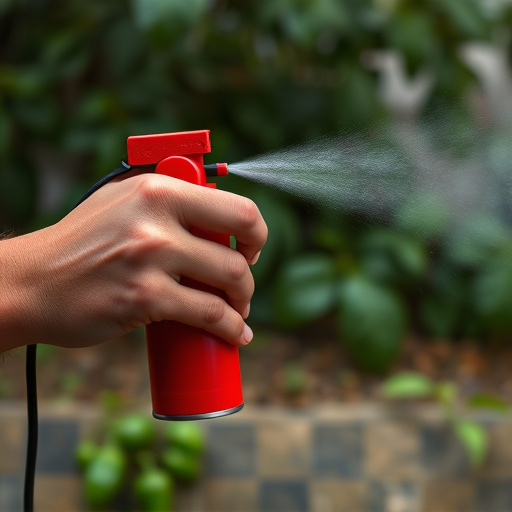Pepper spray gel and stream offer distinct advantages in civilian self-defense. Gel sticks to attackers, causing immediate irritation and temporary blindness, while stream provides broader coverage with a high-pressure cloud. Stream sprays excel in quick reaction scenarios, and gel is ideal for direct contact situations. Understanding legalities and responsible usage ensures effective defense tailored to individual needs.
“In today’s uncertain world, civilian protection through effective self-defense mechanisms has become paramount. One such tool gaining popularity is defensive spray, with two prominent varieties: pepper spray gel and stream spray. This article delves into the intricacies of these substances, examining their active ingredients, efficacy, technological advancements, and practical applications in civilian settings. We explore the legal landscape surrounding ownership while providing insights on responsible use. Understanding these nuances empowers individuals to make informed decisions regarding personal safety.”
- Understanding Pepper Spray Gel: Active Ingredients & Efficacy
- Stream Spray Technology: Range, Projectile Power, and Safety
- Civilian Use Cases: Situational Awareness and Self-Defense Strategies
- Legal Considerations: Regulations, Permits, and Responsible Ownership
Understanding Pepper Spray Gel: Active Ingredients & Efficacy
Pepper spray gel is a powerful personal defense tool designed for civilian protection, offering an effective solution against potential threats. Unlike traditional stream-based pepper sprays that emit a cloud of oleoresin capsicum (OC) oil in a mist form, pepper spray gel utilizes a viscous substance that directly contacts the attacker’s eyes and respiratory system.
The active ingredients in pepper spray gel are typically OC oil and various chemical agents that enhance its effectiveness. When deployed, the gel sticks to the target’s skin and mucous membranes, causing immediate irritation and temporary blindness. This advantage sets it apart from stream sprays, as gel formulations provide closer contact and more targeted protection. The efficacy of pepper spray gel is well-documented, with studies showing it can disable attackers for several minutes, allowing users to escape dangerous situations.
Stream Spray Technology: Range, Projectile Power, and Safety
Stream spray technology offers a more advanced protection system compared to traditional pepper spray gel. The key advantages lie in its range, projectile power, and safety features. Unlike gels that typically have a limited reach and require direct contact with the target, stream sprays can be activated from a distance, making them ideal for self-defense scenarios where quick reaction time is crucial.
The high-pressure stream of liquid pepper spray projects a powerful cloud that can incapacitate an attacker, providing civilians with a better chance to escape. This technology ensures a more precise and effective application, minimizing the risk of accidental cross-contamination or off-target effects. Moreover, stream sprays are designed with safety in mind, featuring triggers that require a firm press to activate, reducing the likelihood of unintended discharges.
Civilian Use Cases: Situational Awareness and Self-Defense Strategies
Civilian use cases for defensive spray highlight the importance of situational awareness and self-defense strategies. In today’s unpredictable world, individuals often find themselves in potentially dangerous situations, making it crucial to be prepared. Pepper spray gel and stream are two popular options, each with unique advantages.
Pepper spray gel is known for its stickiness, allowing it to adhere to attackers’ eyes, nose, and skin, causing temporary blindness and discomfort. This can provide valuable time for civilians to escape or seek help. On the other hand, pepper spray stream offers a wider range of coverage, making it effective in open spaces where direct contact may be challenging. Understanding these distinctions helps users choose the most suitable defense mechanism based on their specific needs and potential threats.
Legal Considerations: Regulations, Permits, and Responsible Ownership
When considering defensive spray for civilian protection, understanding legal considerations is paramount. In many regions, the possession and use of pepper spray gel or stream are regulated to ensure public safety. Regulations vary by location, with some areas allowing only law enforcement to carry such devices, while others permit civilians under specific conditions. Obtaining permits or licenses is often necessary before purchasing and carrying defensive spray.
Responsible ownership is equally important. Users must be trained in the proper handling and deployment of the spray, understanding both its effectiveness and limitations. It’s crucial to store the device securely to prevent unauthorized access and accidental use. Awareness of local laws and responsible practices ensure that civilians can protect themselves while adhering to legal frameworks, choosing between pepper spray gel and stream formulations based on these considerations.
In evaluating civilian protection options, pepper spray gel and stream technology each offer unique advantages. While pepper spray gel provides a reliable range of effectiveness against close-range aggressors, stream spray technology boasts enhanced reach and accuracy. When deciding between the two, understanding their respective pros and considering legal frameworks is paramount. Whether for self-defense or situational awareness, making an informed choice based on individual needs and local regulations ensures responsible ownership and optimal personal safety.
